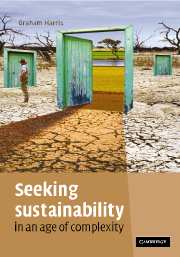Book contents
- Frontmatter
- Contents
- Acknowledgements
- 1 Preamble: the world we are in
- 2 Complexity and complex systems
- 3 New science, new tools, new challenges
- 4 The complexity of ecology
- 5 The generation of complexity
- 6 Micro-interactions and macro-constraints
- 7 A sense of place
- 8 Created landscapes and our changing sense of place
- 9 Catchment form and function
- 10 Catchment loads: ecosystem impacts
- 11 Change detection, monitoring and prediction
- 12 Evidence, uncertainty and risk
- 13 Modified landscapes: biodiversity
- 14 Function in fragmented landscapes
- 15 Environmental flows
- 16 Evidence for global change
- 17 Values and beliefs
- 18 Managing environmental, social and economic systems
- 19 Linking multiple capitals in a changing world
- 20 Community, capacity, collaboration and innovation
- 21 A new environmental paradigm
- 22 Emergent problems and emerging solutions: developing an ‘ecolophysics’?
- 23 Avoiding collapse
- Index
6 - Micro-interactions and macro-constraints
Published online by Cambridge University Press: 21 March 2011
- Frontmatter
- Contents
- Acknowledgements
- 1 Preamble: the world we are in
- 2 Complexity and complex systems
- 3 New science, new tools, new challenges
- 4 The complexity of ecology
- 5 The generation of complexity
- 6 Micro-interactions and macro-constraints
- 7 A sense of place
- 8 Created landscapes and our changing sense of place
- 9 Catchment form and function
- 10 Catchment loads: ecosystem impacts
- 11 Change detection, monitoring and prediction
- 12 Evidence, uncertainty and risk
- 13 Modified landscapes: biodiversity
- 14 Function in fragmented landscapes
- 15 Environmental flows
- 16 Evidence for global change
- 17 Values and beliefs
- 18 Managing environmental, social and economic systems
- 19 Linking multiple capitals in a changing world
- 20 Community, capacity, collaboration and innovation
- 21 A new environmental paradigm
- 22 Emergent problems and emerging solutions: developing an ‘ecolophysics’?
- 23 Avoiding collapse
- Index
Summary
How large-scale system properties arise from small- scale interactions and patch dynamics. The implications for sustainability.
If we think of landscapes and waterscapes as patterns of shifting mosaics and interactions across scales – which arise from HOT designs and from Self Generated Complexity (SGC) – what does this new world view do to our attempts to manage these systems? For a more sustainable global future and for land- and waterscape restoration to be successful there is an urgent need to better understand the complex linkages and pathways between biodiversity, land use, soil properties, hydrology and water quality because these are the dominant forces which shape our ability to manage landscapes and waterscapes sustainably. Clearly, the dominant world view has not been a raging success because evidence of landscape and waterscape degradation abounds. So something is wrong with our dominant paradigm. Progress can be made if we look at landscape and waterscape function from the perspective of small-scale pattern and process and the emergence – through SGC – of some larger, macroscopic properties. I shall argue here that what was partly wrong with the previous paradigm was the neglect of those inconveniently small scales of pattern and process (inconvenient, that is, for a two-metre primate that lives for decades) and the neglect of global and regional constraints and emergent properties. Having understood some of these processes there is a need to implement better management and restoration frameworks.
- Type
- Chapter
- Information
- Seeking Sustainability in an Age of Complexity , pp. 69 - 82Publisher: Cambridge University PressPrint publication year: 2007

